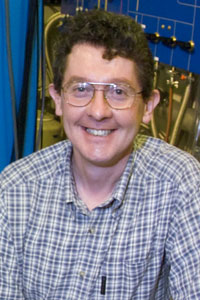| Posted: January 7, 2010 |
Findings hint at common mechanism for high-temperature superconductivity in two families |
|
(Nanowerk News) An international team lead by scientists at the U.S. Department of Energy’s (DOE) Center for Emergent Superconductivity, an Energy Frontier Research Center headquartered at DOE’s Brookhaven National Laboratory, has discovered evidence for ‘electronic liquid crystal’ states within the parent compound of one type of iron-based, high-temperature (high-Tc) superconductor.
|
 |
| J.C. Seamus Davis
|
|
“Because these findings appear similar to what we have observed in the parent state of cuprate superconductors, it suggests this could represent a common factor in the mechanism for high-Tc superconductivity in these two otherwise very different families of materials,” said team leader Séamus Davis, Director of the Center for Emergent Superconductivity at Brookhaven and the J.D. White Distinguished Professor of Physical Sciences at Cornell University. The team of scientists describes their findings, which may help elucidate that long-sought mechanism and lead to higher-temperature superconductors, in the January 8, 2010, issue of Science.
|
|
The findings came as a surprise because many theorists had expected the iron-based materials to act more like conventional metal superconductors, where electrons pair up to carry current effortlessly, but without requiring any specific spatial arrangements. These materials must be kept at nearly absolute zero, or -270 degrees Celsius, to operate as superconductors.
|
|
In contrast, the newer cuprate and iron-based superconductors operate at a range of warmer, though still chilly, temperatures (e.g., -120 degrees Celsius for cuprates and -220 degrees Celsius for iron-based compounds) that make them potentially more practical for large-scale, real-world applications such as zero-loss power transmission lines. Understanding the mechanism or mechanisms by which they operate could open the door to engineering even warmer, or ideally, room temperature, versions.
|
|
The scientists conducted their study through the use of a newly improved and uniquely sensitive spectroscopic image-scanning tunneling microscopy (STM) technique. Davis was recently awarded the Kamerlingh-Onnes Prize for pushing the limits of this technique, which allows direct imaging of the arrangements of electrons in materials and exploration of the electronic structure of exquisitely prepared crystals containing calcium, iron, cobalt, and arsenic. A research group at DOE’s Ames Laboratory led by Paul Canfield, Ames Laboratory Senior Physicist and Iowa State University Distinguished Professor of Physics and Astronomy, fabricated the iron-based crystals.
|
|
An important breakthrough was the capability demonstrated by the team to achieve atomically flat and perfectly debris-free surfaces for these studies. Without these conditions the spectroscopic imaging STM techniques cannot be applied. But as soon as the first large-scale images of the electronic arrangements were achieved, it became clear to the team that they were onto something very different than expected.
|
|
The scientists observed static, nanoscale arrangements of electrons measuring about eight times the distance between individual iron atoms, all aligned along one crystal axis reminiscent of the way molecules spatially order in a liquid crystal display. They also found that the electrons that are free to travel through the material do so in a direction perpendicular to these aligned ‘electronic liquid crystal’ states. This indicates that the electrons carrying the current are distinct from those apparently aligned in the electronic liquid crystals.
|
|
The next step will be to see how these conditions affect the superconductivity of the material when it is transformed to a superconductor.
|
|
“Then, if we’re able to relate our observations in the iron-based superconductors to what happens in cuprate superconductors, it may help us understand the overall mechanism for high-Tc superconductivity in all of these materials. That understanding could, in turn, help us to engineer new materials with improved superconducting properties for energy applications,” Davis said.
|
|
In addition to those institutions already mentioned, scientists from the following institutions collaborated on this research: the National High Magnetic Field Laboratory at Florida State University and St. Andrews University, Scotland. The research was funded by: DOE’s Office of Science, the National Science Foundation, the Office of Naval Research, the U.K. Engineering and Physical Sciences Research Council, and the Scottish Funding Council.
|

